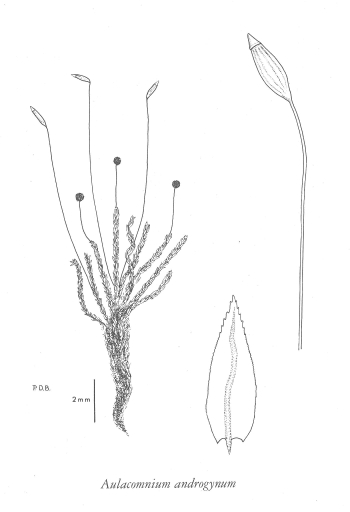Aulacomnium androgynum (Hedw.) Schwaegr.
lover's moss (aulacomnium moss)
Aulacomniaceae
Species Account Author: Wilf Schofield
Extracted from Some Common Mosses of BC
Introduction to the Bryophytes of BC
lover's moss (aulacomnium moss)
Aulacomniaceae
Species Account Author: Wilf Schofield
Extracted from Some Common Mosses of BC
Introduction to the Bryophytes of BC
Species Information
Species description:
Genus name derived from the furrowed sporangium; the mnium portion of the name being an ancient Greek name for moss. The species name derived from the assumed bisexual condition of the moss, based on a misinterpretation of the gemma-bearing shoot as a male shoot.
Reproduction:
Sporophytes common, maturing in spring, reddish-brown; gemma-bearing shoots common on non-sporophyte-bearing plants, especially conspicuous in winter and late summer. The dusty gemmae fall off readily.
Distinguishing characteristics:
The spherical masses of gemmae on elongate shoots are unique to this moss in the provincial flora. Any pale yellow-green, tufted moss found on relatively dry wood surfaces is likely to be this species. Sporangia are distinctive with parallel grooves and two rows of peristome teeth.
Habit:
Usually forming bright yellow-green tufts or turfs of erect shoots.
Similar Species:
Tetraphis pellucida grows in similar habitats but its peristome has four teeth, the sporangia are not grooved and gemmabearing shoots are usually terminated by a leaf-fringed cup. A. palustre tends to be larger, grows in terrestrial, usually wet, habitats and has gemma-bearing shoots terminated by a small irregular cluster of gemmae. See also notes under Ceratodon purpureus.
Illustration

If more than one illustration is available for a species (e.g., separate illustrations were provided for two subspecies) then links to the separate images will be provided below. Note that individual subspecies or varietal illustrations are not always available.
Illustration Source: Some Common Mosses of BC
Habitat and Range
Habitat
Usually on decaying wood of stumps or logs, or peat-like turf, occasionally on rock, tree trunks and disturbed mineral soil. Frequent on fence posts, rail fences and charred stumps. Common near the coast in both woodland and open areas from sea level to subalpine; less common in the interior. Range
World DistributionCircumboreal, also in southern South America; in North America across the northern portion of the continent and extending southward to West Virginia in the east and California in the west.